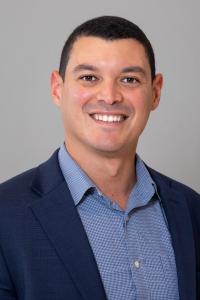Ricardo Cruz-Acuña, PhD: Paying It Forward
Growing up in Puerto Rico, Ricardo Cruz-Acuña, PhD, was taught from an early age to value education. His parents, who were first-generation college students, always emphasized the importance of learning and attending school.
In high school, Cruz-Acuña found himself drawn to science and engineering topics, but he always wanted more than his classes could provide. He decided to enroll at the University of Puerto Rico - Mayagüez Campus, whose College of Engineering is not only the largest in Puerto Rico, but also one of the top producers of Hispanic engineers in the U.S.
“Once I was there, I started realizing all the opportunities that were beyond the small island of Puerto Rico, in terms of a career in science,” says Cruz-Acuña, assistant professor of cancer engineering in the College of Dental Medicine at Columbia University Irving Medical Center and member of the Tumor Biology and Microenvironment Program at the Herbert Irving Comprehensive Cancer Center (HICCC). “I was becoming hungrier for learning, for research, and for moving the needle in science.”
Cruz-Acuña's Cancer Engineering Lab
Today, Cruz-Acuña is the principal investigator of his own lab at Columbia. His research integrates aspects of biomaterial engineering, cell and molecular biology, and 3D organoid biology to better understand the initiation and progression of cancer. He creates engineered patient-derived 3D organoids — essentially, miniaturized and simplified model organs from patient tumor biopsies — that can be leveraged for therapeutic studies and personalized medicine applications.
“Cancer engineering is a relatively new field that uses engineering tools to develop solutions and technologies tailored to cancer,” he says. “The ultimate goal of our work is to understand how cancer behaves in response to its microenvironment, and by doing so, we can then identify novel targets within the cells that we can use to inhibit its progression.”
The tumor microenvironment consists of cancer cells surrounded by diverse non-malignant cell types, collectively embedded in an extracellular matrix. Changes in the tumor microenvironment, such as increased stiffness of the extracellular matrix, can drive cell transformation, cancer progression, and metastasis. Improved 3D culture models that closely mimic the tumor microenvironment enable researchers to uncover potential drivers of disease.
“We create models to investigate how the tumor microenvironment supports the initiation and the progression of cancer,” says Cruz-Acuña. “We use an engineered biomaterial called hydrogel, and the cool thing about hydrogels is that we can easily tune its physical and chemical properties to better understand how the cancer cells respond to those changes.”
His research primarily focuses on the oral-esophageal tract, with potential applications to other gastrointestinal organs. "Given that the global prevalence of cancer continues to rise, there is an urgent need for a transformative and multidisciplinary approach in cancer research that facilitates early detection and treatment," says Cruz-Acuña.
Cruz-Acuña and his colleagues grow their patient-derived 3D organoids in a specialized gel that imitates the body's natural extracellular matrix—the supportive environment surrounding cells. By adjusting the stiffness of this gel, the team can replicate different conditions found in human tissues. Their work has demonstrated that esophageal adenocarcinoma cell growth and proliferation can be controlled by extracellular matrix stiffness, consistent with what has been observed in the clinic. When the gel becomes stiffer, it triggers changes in the genes associated with tumor growth and progression.

Patient-derived 3D organoids grown in engineered hydrogel.
These gene changes could be targeted for therapy, helping to develop treatments that focus on the stiffness of the tissue in esophageal cancer. Additionally, the modular nature of the engineered 3D organoid culture system can be modified to investigate other diseases.
“We work with very tunable technologies that can serve as a platform to study different types of cancers,” he says. “And our work is very patient-specific, given that we use patient cells to do our work, so it has a personalized medicine approach.”
Cruz-Acuña credits his scientific mentors for helping him achieve professional success, including Anil K. Rustgi, MD, the Herbert and Florence Irving Director of the HICCC. He joined the Rustgi lab, first at University of Pennsylvania and later at Columbia, for his postdoctoral research training.
“My mentors advocated strongly for my success, and I really want to pay it forward for the new generation of underrepresented minority scientists,” he says. “I feel privileged to be where I am today, and it gives me a stronger opportunity to extend my hand and help others, just like I was helped during my career.”

